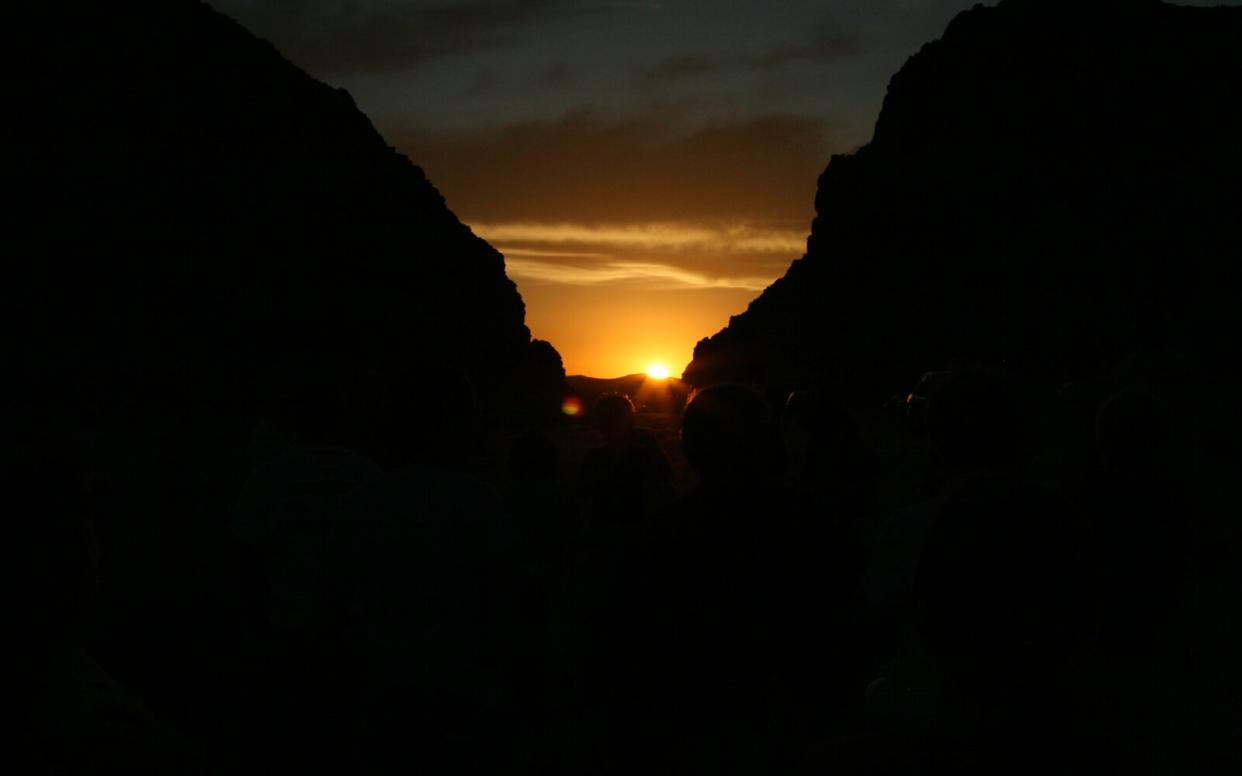Utah's Weirdest Place Has Sliding Sunsets, a Moon Map, and Prehistoric Petroglyphs

Courtesy of Brian Head Tourism Sunset at Parowan Gap, Utah.
While Stonehenge, in the U.K., famously frames the setting sun on the winter solstice — the year's shortest, darkest day — there are scores of lesser-known monuments that are celestially aligned.
Egypt's Karnak Temple and the Temple of Pachacamac in Peru are two you may have heard of, but far fewer know about the mysterious Parowan Gap in Iron County, Utah.

Jamie Carter
At first glance the landscape looks empty. Turn off the Utah State Route 130 onto Gap Road about 14 miles north of Cedar City and the road leads first past a stop for dinosaur tracks, and then towards a natural 600-foot gap in the mountains. Stop at the correct spot in front of the gap and, as the sun sets on December 21, you'll get to see compelling evidence that this entire landscape is a Native American calendar.
Related: A Guide to Utah's National Parks
“The sun rolls down the side of one outcrop and sits in a notch between the two before it drops,” said Nancy Dalton, Parowan Heritage Foundation secretary, who has spent many early mornings and dusks here. “As the sun gets close to that little notch all of a sudden people go silent.”
The winter solstice viewing point is on the north side of the Gap road, and there are two cairns—one distant and one closer to the Parowan Gap itself—to mark exactly where to stand. To the south are more cairns marking the same spots for the summer solstice, and more sets for the equinoxes.
These cairns are estimated to be up to 10,000 years old and the product of the Fremont and Paiute Native American tribes.
“They needed to know seasonal rotations in order to survive,” said Dalton, who wants to create a “weatherman's trail” that passes close to these cairns and solstice points complete with markers for each week, so visitors can stand in exactly the right place on any day of the year and watch the sun set into the Parowan Gap.
However impressive the cairns' precise placement, they're merely a precursor to what lies within the Parowan Gap itself.
Although there are petroglyphs here reckoned to be birthing calendars and migration maps, the most startling is the Zipper glyph. Thought to be a solar calendar, the V-shaped image (reminiscent of a zipper) etched into the rock appears to replicate the Parowan Gap's appearance from afar, and was the clue to finding the ancient cairns beyond that indicate where to stand as solstices and equinoxes.

Jamie Carter Petroglyphs, on the rocks at Parowan Gap, Utah.
Another petroglyph depicts the monthly lunar cycle, with quarter moons and the full moon all shown, though a nearby canoe-shape with 18 boxes is even thought to depict the complex 18-year lunar cycle of Earth, which involves subtle changes to the inclination of the moon’s orbit. This is impressive stuff.
On the southern outcrop of the Parowan Gap is a rock formation that resembles a protracted face, complete with a slit that looks like a mouth.
“We call this the Overseer,” said Dalton. “He swallows the Sun at the end of summer and spits it out again in Spring.”
The story goes that on two successive sunrises in early November each year the Overseer swallows the sun, with the reverse spectacle in early February.
“At about 7:30 a.m. you can watch the sun come up over the horizon and instead of passing through the slit it rolls to the back of his mouth until he swallows it,” said Dalton. “This told the people that the summer sun was gone and it was time to prepare for cold weather.”
How could the sun possibly appear to go backwards through a rock as it rises? “We had an astronomer down here who couldn't believe it, but he saw it alright,” Dalton said.

Courtesy of Brian Head Tourism; Photo by Alex Santiago The Overseer.

Hayden Hess The sun seen through the Overseer, at Parowan Gap.
The Overseer's abilities as an ancient meteorologist might be a geological coincidence, but there's no denying that the Parowan Gap is a place where an immense amount of research went in marking the passing of the seasons. Not only were exact sunset points for years on end meticulously observed, measured and recorded, but a massive amount of petroglyphs were carved into the rock faces of the Parowan Gap. This place is a book and a map as well as a calendar.
Related: 13 Otherworldly Destinations Perfect for Stargazing
There are other shadow markers within the petroglyphs, with one tiny outcrop in particular creating a shadow that moves inwards until the spring equinox, then outwards again.
“The light comes across the valley and into the gap and washes over it just like the waves on a beach,” said Dalton. “It's a spiritual experience to be out here.”
